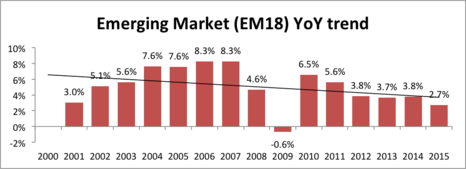It’s our Crystal anniversary! We’re celebrating 15 years of helping our clients grow
Reading Time: < 1 minuteRainmakers CSI opened its doors in October 2007, a time when the world was heading towards financial…
LEARN MOREPlanning for significant brand growth in Emerging markets has become very challenging now that the rate of economic growth of these countries is in decline.
Until recently we could assume GDP per capita growth rates of 6-8% in the most important Emerging markets. Now that is down to about 2-3%.

GDP PPP per capita based on IMF’s World Economic Outlook database: Bangladesh, Brazil, China, Colombia, Egypt, India, Indonesia, Iran, Korea, Malaysia, Mexico, Nigeria, Pakistan, Philippines, Russia, South Africa, Thailand, Vietnam
This rate of Emerging market expansion is now about the same as that of the more Developed OECD markets which until recently have been regarded as less attractive growth prospects.

GDP PPP per capita based on IMF’s World Economic Outlook database: Australia, Austria, Belgium, Canada, Chile, Czech Republic, Denmark, Estonia, Finland, France, Germany, Greece, Hungary, Iceland, Ireland, Israel, Italy, Japan, Korea, Luxembourg, Mexico, Netherlands, New Zealand, Norway, Poland, Portugal, Slovak Republic, Slovenia, Spain, Sweden, Switzerland, Turkey, UK and USA.
Economists have noted that economic growth in the Emerging markets has slipped as these nations struggle with the impact of a stronger US dollar and weaker commodity prices. “This slowdown has been longer in the making and is driven largely by internal factors. This is a new normal likely to persist for a decade or so,” says Neil Shearing of Capital Economics.
This development has big implications for planning international brand growth strategies in these countries. It is not as straightforward as it once seemed. Emerging markets no longer have the inbuilt advantage of a higher growth dynamic than Developed countries. We can no longer rely on general economic momentum to drive significant growth in international brand sales. Period.
In this new normal we argue that international brand owners now have to go out and look for opportunities for brand growth by finding the cultures and consumers that offer the right “fit” for their brand. This puts the emphasis on the need for smarter marketing.
This involves making the right choices about where you can most successfully extend your brand internationally, and setting clear investment priorities. The key is to identify the markets where there is a natural harmony between the proposition a particular brand can deliver and the underlying factors which condition and drive consumer behaviour:
Finding the “right fit” for each of your brands will provide the momentum and leverage against competitors that will spur growth, but also allow you to manage your brand portfolio across countries more effectively.
A couple of examples.
In personal care, markets at similar levels of economic development behave in dramatically different ways. In part, this is due to the most fundamental values which consumers embrace. For example, the (very different) cultures of Brazil and India are more likely to favour natural solutions, while in Russia “glamour” is more appealing as an aspirational value.
And the impact of these deep rooted influences goes far beyond consumer products. In financial services, values like prudence and financial conservatism which have been ingrained in some cultures for centuries intertwine with the legacy of more recent experiences, like whether a country went through a communist phase, in determining people’s expectations and behaviour.
It is not impossible to create a global brand that can succeed more or less anywhere, but in today’s complex and exceptionally dynamic consumer world it’s a rare achievement. The reality is that by picking the battles you can more easily win, you are much more likely to generate strong growth.
The days of pouring over spreadsheets that predict universal growth in Emerging markets are gone. The trick is to understand the consumer fundamentals, and make the smart market growth strategy choices for your brand. And the answer often isn’t just Brazil, Russia, India, and China…